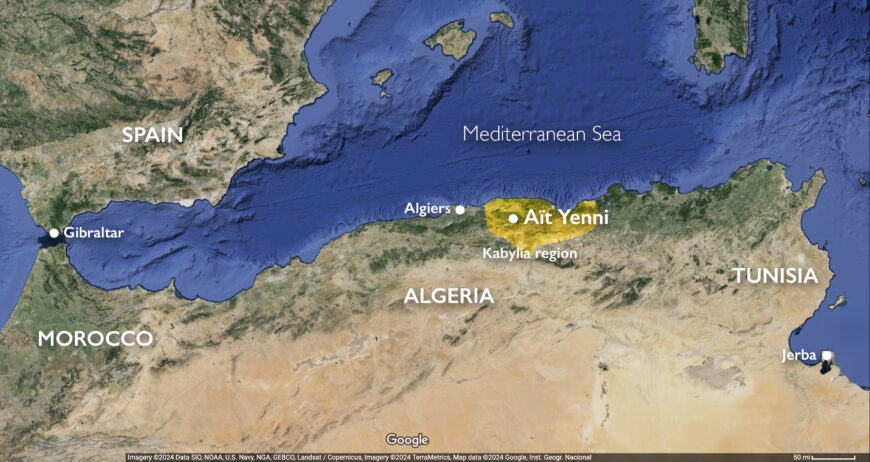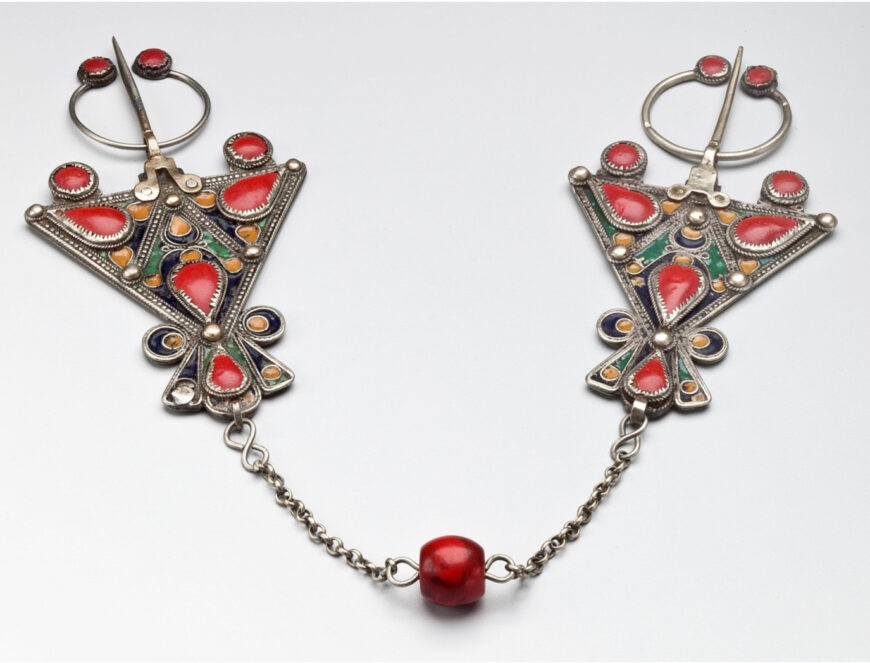
Kabyle fibulae (brooches), late 19th–early 20th century, silver, enamel, and coral (The Newark Museum of Art)
One of the most ubiquitous pieces of jewelry in northern Africa is the brooch. Often referred to in English by the Latin term, fibulae (plural), brooches consist of two pins and a pendant joined by a chain. Fibulae were commonly worn by women every day. They pinned the two sides (back and front) of a draped garment at a woman’s shoulders. Each region in northern Africa had its own style of fibulae, and Kabyle brooches, such as the ones in the Newark Museum collection, are immediately recognizable due to the use of blue, yellow, and green enamel, as well as red coral. Jewelry making was centered in the town of Aït Yenni located in the Grande Kabylie Mountains, a region located at the edge of the Mediterranean Sea inhabited by Amazigh people. Unlike other regions in northern Africa, both Muslim and Jewish silversmiths produced jewelry in Aït Yenni, and it remains one of the few regions where enameled jewelry continues to be made today. While the use of fibulae went into decline during the 20th century, brooches continue to be worn during special occasions, such as weddings as an expression of Kabyle heritage and identity.
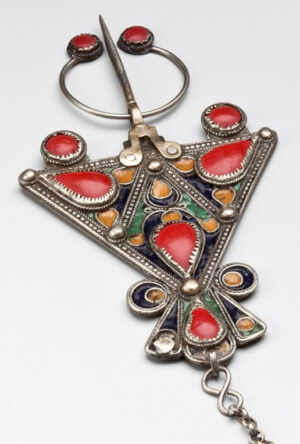
Pendant (detail), Kabyle fibulae, late 19th–early 20th century, silver, enamel, and coral (The Newark Museum of Art)
Techniques of manufacture
Kabyle artisans made fibulae by melting down silver coins, older pieces of jewelry, or other metals, resulting in pieces with relatively low silver content. Jewelers hammered the metal into various forms and created surface patterns by soldering twisted wires to them, forming walled recesses where enamel and coral could be placed. Enameling is a widespread, ancient technique of adorning metal with brilliant colors that involves coloring powdered glass with the addition of metal oxides. This material is applied to a metal surface and subjected to intense heat, which causes it to melt and become fixed to the surface. Bright red coral harvested from the Mediterranean Sea was also used in fibulae. Jewelers would polish and shape the coral into its desired form to be embedded onto the surface of the brooches. Coral is believed to have prophylactic abilities that protect the wearer against the evil eye and has been used in the Mediterranean region since antiquity. By the end of the 19th century, it became common for jewelers to produce imitation coral using dyed gypsum and marble powder that they formed into various shapes and held together with glue. Jewelers eventually began to use plastic imported from Europe, which was easier to work and less expensive. [1]
The client rather than the jeweler would have determined details concerning the size, weight, and types of materials used, such as coral or plastic. Some fibulae are joined with a chain composed of small, enameled pendants with a small enameled amulet box at the end. If costs were an issue, a client simply used a cord to link the two brooches or a chain like the fibulae in the Newark Museum collection. The chain in these fibulae, however, were joined with a large coral bead, adding to their value. The design of fibulae reflects an aesthetic of symmetry and movement that is a feature of Amazigh art more generally, echoing the symmetry of the human body. As the wearer walks, the chain moves to the rhythm of her body, increasing the aesthetic beauty of the jewelry by adding a kinetic element.
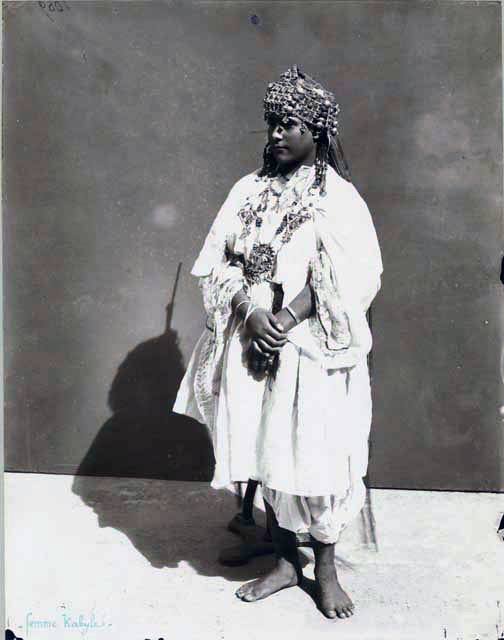
Kabyle woman wearing fibulae, before 1946, print, black and white adhered to paperboard, 25.4 x 20.3 cm (Peabody Museum of Archaeology & Ethnology, Harvard University, Cambridge, MA)
Gendered status symbols
A young woman in Kabylia would have received such fibulae on her marriage, purchased by her parents using the dowry provided by her fiancé’s parents. Other pieces of jewelry would include a diadem, earrings, bracelets, anklets, and a necklace. After her wedding, women wore bracelets, earrings, and maybe a lighter pair of fibulae daily, preserving heavier and more elaborately decorated pieces like these for religious ceremonies and other social occasions.
The triangular form typically used to create the fibulae’s pendant is one of the most common motifs found in Amazigh art. The triangular shape with its very long pin has been interpreted by colonial-era scholars from Europe as providing protection from the evil eye, as the pin metaphorically could pierce an eye and protect the user of the jewelry. Kabyle women once commonly painted the interior walls of their homes with motifs based on the triangular forms, and women wove the triangular forms into their textiles and painted triangle shapes on ceramics, suggesting that the triangle served as a highly gendered symbol associated with female fertility.
Aït Yenni: a center for Amazigh jewelry
This fibulae was made in the early 20th century in the town of Aït Yenni (also known as the Arabized name Beni Yenni). Located in the Greater Kabylia region of northern Algeria, Aït Yenni is a center for jewelry manufacture and hosts a jewelry festival each summer. In fact, Aït Yenni remains one of the few places in North Africa where enamel work continues to be done. Other Amazigh areas where enamel work is still used to decorate jewelry include the island of Jerba in Tunisia and the Anti-Atlas region of Morocco, however, each region has developed its own particular style. In fact, a great deal of regional variation exists across northern Africa, suggesting that women’s brooches served as markers of regional identity.
However, Aït Yenni was profoundly impacted by the French occupation that began in 1857. In response to an 1871 Kabyle rebellion against French rule, colonial forces confiscated most of the agricultural land in the Greater Kabylia and established an administrative center at Aït Yenni. European tourism began to flourish, and Kabyle artisans began making pottery, textiles, and jewelry for foreign clientele. While some jewelry was made specifically for the market, struggling families also sold pieces originally created for personal use. In 1883, a British traveler to Algeria wrote about the difficulty in purchasing examples of Kabyle jewelry, since many locals had already sold off their family’s jewelry due to famine or because of the heavy fines imposed by the French. [2] The fibulae in the Newark Collection were acquired in 1929 after John Cotton Dana, the Newark Museum’s first director, purchased it in Algeria.
Symbols of Amazigh identity
At the time when travelers carried portable pieces of North African jewelry back to Europe and the United States, the fibulae began to transform from a functional pendant to an object representative of Amazigh identity. Women’s dress began to transform with the introduction of cloth imported from Europe and elsewhere, and Kabyle women began to wear tailored garments no longer requiring fibulae to keep them fastened. The fibulae took on a new life as a symbol of Amazigh pride, especially in post-colonial Algeria.
After the end of the colonial period, the Algerian government engaged in an intense Arabization policy that viewed linguistic diversity as a threat to national unity. Kabyle, as native speakers of Tamazight, began to stage protests. One of the most renowned series of protests began in April of 1980 when Algerian authorities canceled a lecture on Kabyle poetry by the Kabyle scholar Mouloud Mammeri at Tizi Ouzou, the largest city in the Grande Kabylie. Referred to as the Berber Spring, it led to the mobilization of an Amazigh cultural movement in Algeria and inspired a larger Amazigh renaissance across northern Africa.
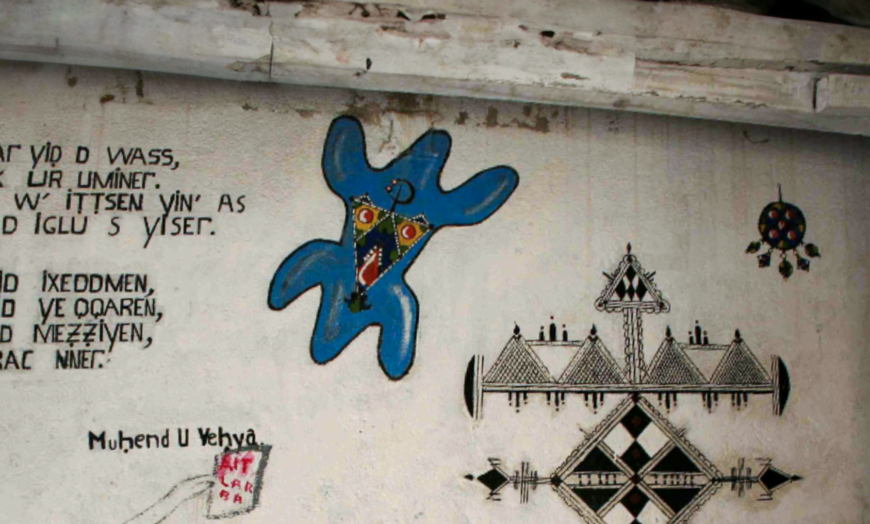
Graffiti on the entrance to a Kabyle village located outside of the city of Tizi Ouzou, 2006 (photo: © Cynthia Becker)
Across the Kabyle region today, graffiti often features symbols of Amazigh pride, including the fibulae. An unknown graffiti artist painted a single Kabyle brooch in the center of a blue human-like figure. The blue figure represents the letter Z written in Tifinagh, the ancient Amazigh writing system. Z is the central letter in the word Imazighen, which means “free people” in the Amazigh language. As a symbol of empowerment, the letter Z, called an aza, has even been placed in the center of the Amazigh flag.

Amazigh flag being held by three generations of Amazigh women in Everett, MA, 2010 (photo: © Cynthia Becker)
In 1997, members of the Amazigh linguistic and cultural movement gathered at a meeting in the Canary Islands to create a flag to symbolize Amazigh identity. Activists chose to create a flag with three large horizontal stripes, using the same colors used in Kabyle enamelwork: blue, green, and yellow. Its stripes refer to the sky (blue), pastures (green), and the desert (yellow), referencing the natural environment and, by extension, the transnational Amazigh homeland that extends from the Canary Islands in the west to the Siwa Oasis in Egypt in the east. The red of the flag’s central motif (the aza) represents struggle but is also reminiscent of the red coral beads used to adorn Kabyle fibulae.
The result is the conflation of Amazigh identity and freedom with the fibula itself. The fibula has taken on many stages through its lifetime, but for the Amazigh people it has been transformed from holding regional and symbolic meaning to becoming a symbol of pride in Amazigh identity.


